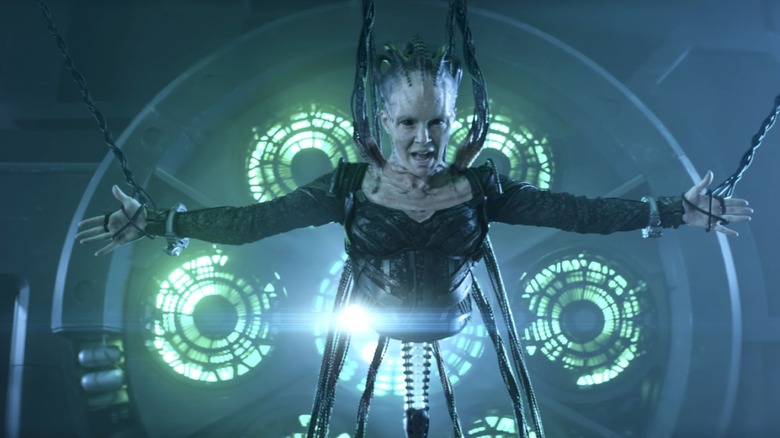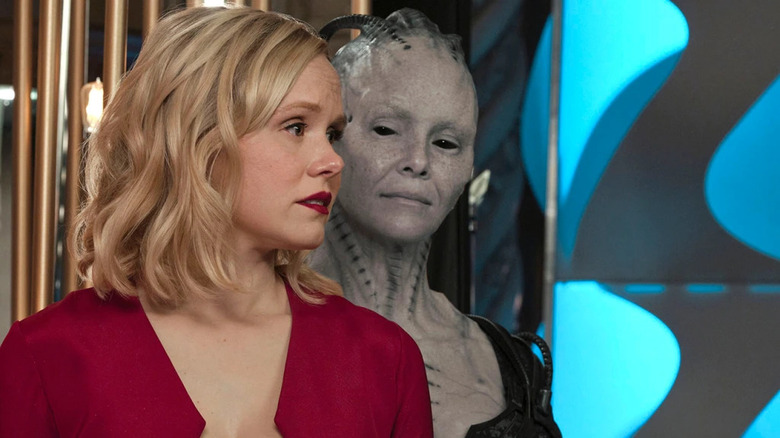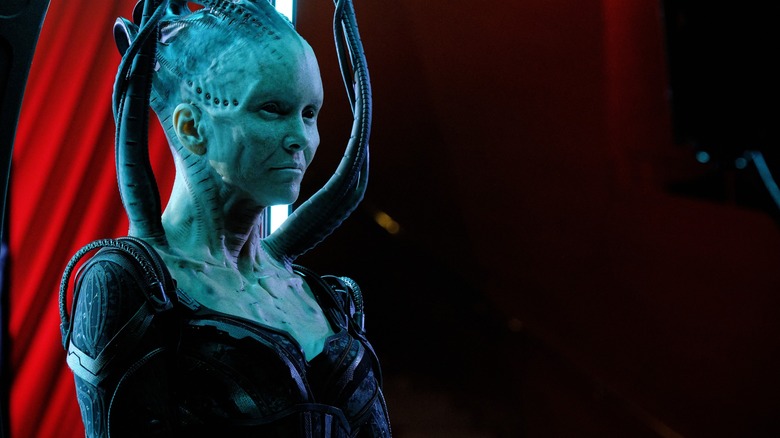Annie Wersching Was A Perfect Fit For Star Trek: Picard's Borg Queen Prosthetics
The second season of "Star Trek: Picard" featured a convoluted plot. In it, Admiral Picard (Patrick Stewart) was abruptly whisked off to a parallel dimension by the trickster god Q (John De Lancie) where the Earth had descended into a fascist hellscape. All of Earth's enemies had been wiped out by the planet's military, and humanity was on the verge of killing the very last Borg. To address the problem, Picard and his friends have to travel back in time to the year 2024 to discover how everything went sour. But to make the complex calculations required for time travel, Picard had to kidnap the Borg Queen (Annie Wersching), a malevolent half-machine super genius, and wire her into a ship's engines.
The Borg Queen, however, is a supervillain who takes every opportunity to escape or to talk her way into infiltrating the mind of the mild-mannered Dr. Jurati (Alison Pill). Later in the series, that very thing happens, and the two characters merge into one.
Annie Wersching, who passed away on January 29, 2023 at the age of 45, played her role to the nines, gnashing and snarling with the best of them. She also looked quite threatening in the Borg makeup, which involved black eyes, a large mechanical skull, and tubing that snaked into and through her neck. For much of "Picard," she also had no bottom half, her torso suspended in midair by cables. In a behind the scenes video on Decider, makeup designer Neville Page revealed that Wersching's head was uniquely suited for the kinds of prosthetics she had to wear, as her skull was perfectly symmetrical, and, by astonishing coincidence, nearly the exact same size as Page's own head.
Annie Wersching's perfect skull
Makeup artists, as a matter of course, typically design and build elaborate facial prostheses using a fake plastic head onto which they can mold the pieces. In many cases, an actor's face is cast in plaster, and the rubber makeup pieces are formed to specially fit the contours of their own head. Prior to that, however, the larger pieces are formed on a mere dummy head, usually taken from someone in the makeup studio. Page had a copy of his own head to work with, and found that forming the gigantic head piece on himself worked out pretty well for Wersching as well. He said:
"Her head is perfect. She's got perfect symmetry. It was just serendipitous, quite frankly, that my head — the proxy head I used — was almost the exact same shape. Not the face, but the skull shape was almost the same. So I could take the design and put it on Annie and, with a few tweaks, make it work. Then it was a tremendous amount of painful, unnerving 'Will this work? Will this fit? Will it be stable on her head?' And [makeup designer] Vincent [Van Dyke] and I sweat it for so long, because it was a tricky one!"
Wersching, meanwhile, learned to enjoy the lengthy process, saying:
"This is, by far, the most prosthetics I've ever worn ... I've had little, like, wounds before, but nothing even close to this extent. It felt super weird at first, but I adapt to things pretty quickly and it doesn't bother me at all anymore. And I had such fun with the guys that were doing it, so it ended up being great."
Werching also clearly had a great time acting in the makeup, because her Borg performance is a hoot.
The process
The head makeup designer on "Picard," James MacKinnon, laid out Wersching's makeup process in even more detail. He explained:
"The makeup took about four hours to start. We got it down to an hour and 45 minutes, which is crazy fast. Annie was in about 13 to 15 pieces, put together. There was the crown, forehead, cheeks, back-of-cheeks, sides-of-cheeks, back. Plus there was a lighting system in the helmet, so there were a lot of cables and switches that had to be hidden underneath the prosthetics."
MacKinnon also pointed out that Werching had particularly nice skin, making he and the other technicians a little worried about laying so many buckets of paste on it. He also pointed out that rubberized alien faces and green-toned skins are actually easier to apply than more subtle, human tones. When the goal is to make a face look fantastical, an element of artificiality can handily be forgiven. MacKinnon also recognized that makeup has had to become more advanced in recent years, as cameras have also evolved. If an 8K digital camera can capture every minute detail of a human's face, seams in makeup would be that much more obvious.
Page, MacKinnon, the rest of the artists, and Wersching herself all worked together to make a memorable supervillain character, and both the makeup and the performance were unassailable.


